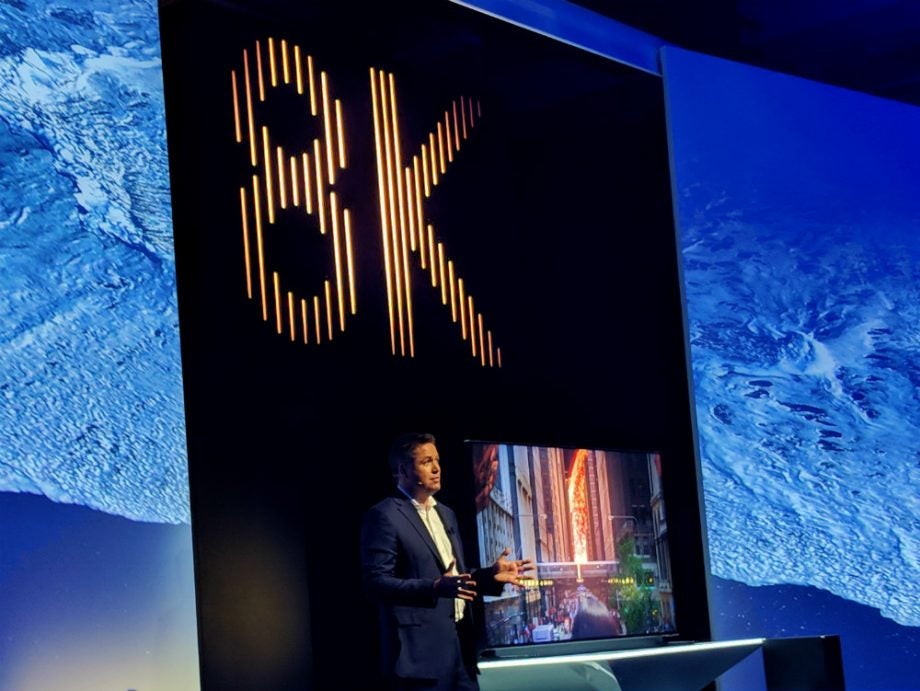Sony and Philips aren’t impressed by Samsung and LG’s 8K shilling at IFA

Walk around the TV circles at IFA 2018 and you’ll hear one topic being discussed more loudly than any other: 8K TV.
Specifically, there’s a lot of attention on Samsung and LG, who are engaged in something of an 8K willy-waving contest. The Samsung Q900R is the first commercially ready 8K LCD TV, with a promised UK market date of October 2018. Fighting for the spotlight is the unnamed 88-inch LG 8K OLED, which could theoretically hit market in a couple of years.
With this in mind, I thought it might be fun to ask other key players in the industry what they make of this IFA ‘trend’ – and they didn’t disappoint.
Sony and Philips? Turns out they’re not really sold on 8K just yet.
First up was Toshi Ogura, Chief Distinguished Engineer at Sony. He admits he has an interest in 8K, but he doesn’t place such weight on resolution.
“Just introducing 8K doesn’t mean anything. Just resolution doesn’t mean anything.”
He refers to the other elements crucial to picture quality, such as colour and contrast. Sony did show off a prototype 8K TV at CES, but the company won’t be making that a retail product any time soon. The same show also featured a display of 10,000 nits’ brightness, which also isn’t heading to shelves.
“We built an 8K prototype, but it’s not our hobby. This is our hobby,” he says, pointing to the new Sony ZF9. “It’s difficult to balance the demands of 8K and the other elements. It takes time, and new technology.”
I point out that the ZF9 comes in 75 inches, which surely is an ideal candidate for 8K resolution. Perhaps there might be an 85-inch version some day in 8K?
“Today we don’t have those products yet,” he says. “But in the future, maybe.”
Next I spoke to Danny Tack, Director of Product Strategy and Planning for TP Vision, who makes Philips TVs. He’s a lot more gung-ho about his reservations, saying that he doesn’t think the industry is ready for 8K, as the dust from the last big TV resolution (4K) has barely settled.
“You will not see 8K from us here [at IFA 2018]. I’m not saying we’ll never do 8K, but HDR isn’t yet standard in the living room, nor is 4K Ultra HD as a source. We’re not yet ready for 8K.”
Mr Tack would rather focus on the present, and he thinks the 8K conversation just is a distraction. He also didn’t waste the opportunity to give his own products a shout out.
“We have something nice here. The P5 processor on the Philips OLED903 can do great things for the consumer, with current 4K sources. Others do not have that strength and put their focus somewhere else.”
He does concede 8K can offer superior quality, but points out there are major limitations around TV sizes, which will limit the market. He’s sceptical about the reality of ordinary people buying large-format TVs in Europe.
“In the end, 8K will show better picture quality, but not on these screen sizes,” he gestures to a line of TVs in 55 and 65 inches. “You’ll have to go to 75 inches, minimum. Or 85. I don’t think there are too many living rooms in Europe that can hold an 85. The market there will have to grow for it to make sense. And then the 8K content will come much later. 8K can become something in the future but this is too early. What will people do, redecorate their living room, sit right in front of it? That’s not going to happen, is it?”
Whichever side of the argument you stand, it’s hard to deny that a massive 8K screen is quite a sight – superficial or otherwise.
What do you think of 8K? Is it another resolution revolution, or have we gone too far? Let us know by tweeting us @TrustedReviews

